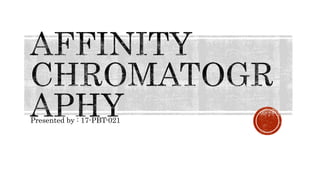
Affinity chromatography
- 1. Presented by : 17-PBT-021
- 2. Affinity chromatography was introduced almost 50 years back as a powerful tool to separate biologically active molecules like protein from a mixture. This was discovered by Pedro Cuatrecasas and Meir Wilcheck in 1968. It uses a unique property of extremely specific biological interactions to achieve separation and purification.
- 3. Binding to ligand:- the crude sample with affinity support is incubated and allow the target molecule to bind to immobilized ligand. Separation:-Washing away of non-bound sample from the support. Elution :- the target molecule is eluted from the immobilized ligand by altering the buffer conditions which interrupts the binding.
- 5. Affinity chromatography is an excellent method to purify or separate a target molecule from a mixture. Theoretically, this method is capable of giving absolute purification, even from complex mixtures, in a single process. It was originally developed for the purification of enzymes, but it has been extended to nucleotides , nucleic acids, immunoglobulins, membrane receptors and even to whole cells and cell fragments. This method is highly based on specific interactions between the molecules. These interactions which are typically reversible are used for purification by placing one of the interacting molecule referred to as affinity ligand onto a solid matrix which will the stationary phase and the target molecules in the mobile phase.
- 6. Matrix : for ligand attachment. The matrix should be chemically and physically inert. Spacer arm : used to improve the binding between the ligand and the target molecule by over coming the affect of steric hindrance. Ligand : the molecule the binds reversibly to a specific target molecule or group of target molecule.
- 7. Matrix is a substance used, usually in a bead form to which a specific ligand is covalently bound. Characteristics: 1. It must be insoluble in the solvents and the buffers used. 2. Should possess suitable and sufficient chemical groups to which the ligand may be covalently coupled, and be stable under the conditions of the attachment. 3. Be stable during binding of the macromolecule and its subsequent elution. 4. Exhibit good flow properties. Sepharose , a bead-form of agarose provides these properties.
- 9. Ligand is the molecule that binds specifically to the target molecule or a group of molecules, enabling purification by the process. 2 factors important for the selection of ligand: 1. The ligand must exhibit specific and reverse binding affinity for the target substance(s) 2. It must have chemically modifiable groups that allow it to the matrix to be attached to the matrix without destroying binding activity. The dissociation constant (Kd) for the ligand –target complex should ideally be in the range 10-4 (enzyme) and 10-8(hormone). Altering elution method may help to promote successful affinity chromatography when the dissociation constant which is outside the useful range. If several functional groups are available, couple the ligand least likely to be involved in the specific affinity reaction. A range of pre-activated matrices for attachment of the ligand through different functional groups are available
- 10. The binding site of a target protein is located deep within the molecule and an affinity medium prepared by coupling small ligands such as enzyme co-factors, directly Sepharose may exhibit low binding capacity due to steric interference i.e. the ligand is unable to access the binding site of the target molecule. In these circumstances the spacer arm is interposed between the matrix and the ligand to facilitate effective binding. Spacer arms must be designed to maximize binding, but to avoid non-specific binding effects. The size and length of the spacer arm is very critical.
- 11. 1. Preparation of column: The solid support (bead matrix) is a gel loaded into an elution column. Sepharose, agarose and cellulose are the most commonly used solid support , because the hydroxyl groups on the sugar residues can be easily manipulated to accept a ligand. The ligand is selected according to the desired isolate. 2. Loading the solution containing the target molecule: the solution is usually a protein rich mixture is poured into the elution column and allowed to run through the gel , at a controlled rate. The target molecule specific for the ligand will covalently bind and the other molecules flowing through. This follows the washing of the column with buffer to remove the unbound molecules.
- 13. • Method 1: In simplest cases, a change of buffer composition elutes the target molecule which is bound • Method 2: extremes of pH or high concentrations chaotropic agents are required for elution, but these may cause permanent or temporary damage. • Method 3 and 4: Specific elution by the addition of substance that competes for binding. These methods can enhance the specificity of the media that use group specific ligands